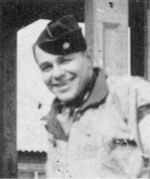Olin F. Brewster

(Interview took place at Sparks, Nevada - 1990)
Task Force Brewster
Olin F. Brewster

(Interview took place at
Sparks, Nevada - 1990)
Page 3
BREWSTER: I went up with six Sherman tank of H Company of the 32nd. Armored Regiment, which were all the tanks we had left in the Company at that time. I had one tank hit on the night of the 23rd. when we were moving in but we were able to repair it and get it back into operation. So when I pulled out on the morning of the 25th. I started out with six tanks, and when I turned East to go to Malempre. I had my lead tank knocked out by a enemy tank judging from the projectile, and then the enemy armor moved in behind me and got my two rears tanks, which left me with three medium tanks at my disposal. The road was blocked in the front and the rear and the terrain was not suitable for cross-country maneuver .So it was agreed wisely that we should destroy the three remaining tanks. And one two and a half and two three quarter ton trucks and the troops walked out on foot safely.
CORBIN: Did you have M-5 Light tank with you?
BREWSTER: I stared out with one and sent it back before we got to the Belle Haie Crossroads.
CORBIN: When you had your roadblock set up, did you destroy any vehicles?
BREWSTER: Yes, we had pretty good luck. They ran quite a few reconnaissance vehicles toward us and with the position we had our tanks set up in with the cut in the road we piled up quite a few Germany vehicles. A German POW reported that the air strike knocked out nine German tanks at the Crossroad, so we knew the Air Force did some damage as we could see smoke coming from the top of the hill. Even thought it was not considered an ideal defensive position, and that was the first time that we had to go and put armor in a truly defensive set up, It did prove that every thing written in the book isn't always the best because we went against everything that had been written in the book but it did prove to be very successful.
CORBIN: What happened to Major. Goldstein who accompanied you on your recon trip toward the Crossroads?
BREWSTER: Major Goldstein had left his unit the 589th Artillery Battery, after Major Parker had been wounded on the morning of the 23rd. of December, and had come to Col. Richardson Headquarters in Manhay and asked for more tanks and troops. Major Goldstein accompanied me when I scouted the Crossroads. I did not see him again as it was impossible to reach the crossroads and it being overrun, I guessed he went back to the rear. I wrote to Major Goldstein a couple years age and received an answer that he remembered me the day of December 23rd, 1944.
Maj. General Maurice Rose was displeased that Maj. Brewster had withdrawn his roadblock and destroyed his remaining tanks. Maj. Brewster told him he was surrounded and broke out after he received orders to get out the best way he could, and getting all my men out safely, was more important than those tanks. Gen. Rose threatened to court-martial Maj. Brewster, but relented when Col. Richardson told him he was proud of Maj. Brewster and the job he did. Gen. Rose had heard about the five tanks from the Seventh Armored Division that had been knocked out in a field just outside of Manhay on the road to Malempre, and may have thought they were of T F Brewster. Because of a planned withdraw to straighten out the 1st. Army's defensive position, The Seventh Armored Divison took over the defense of Manhay from Lt. Col. Richardson on December 24 and withdrew from Malempre late evening into Manhay. The Germans followed them in and captured Manhay.
Maj. Brewster jumped off with Task Force Richardson on the January 3rd. 1945 Offensive. For his action during the first week of the drive he was awarded the Bronze Star medal for bravery and on the eight of January a Purple Heart Medal for being wounded. It was the end of the war for Maj. Brewster.